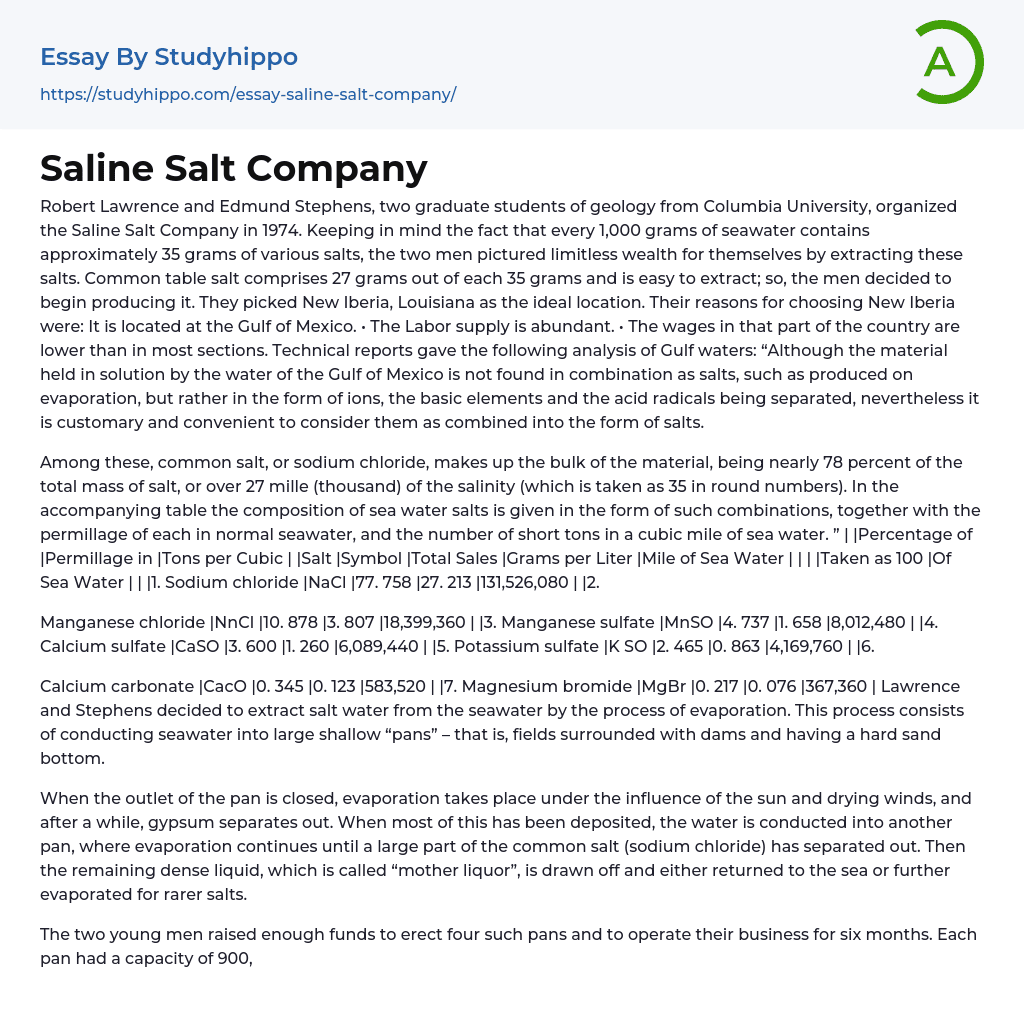Robert Lawrence and Edmund Stephens, two graduate students of geology from Columbia University, organized the Saline Salt Company in 1974. Keeping in mind the fact that every 1,000 grams of seawater contains approximately 35 grams of various salts, the two men pictured limitless wealth for themselves by extracting these salts. Common table salt comprises 27 grams out of each 35 grams and is easy to extract; so, the men decided to begin producing it. They picked New Iberia, Louisiana as the ideal location.
Their reasons for choosing New Iberia were:
- It is located at the Gulf of Mexico.
- The Labor supply is abundant.
- The wages in that part of the country are lower than in most sections.
Technical reports gave the following analysis of Gulf waters: “Although the material
...held in solution by the water of the Gulf of Mexico is not found in combination as salts, such as produced on evaporation, but rather in the form of ions, the basic elements and the acid radicals being separated, nevertheless it is customary and convenient to consider them as combined into the form of salts.
Among these, common salt, or sodium chloride, makes up the bulk of the material, being nearly 78 percent of the total mass of salt, or over 27 mille (thousand) of the salinity (which is taken as 35 in round numbers). In the accompanying table the composition of sea water salts is given in the form of such combinations, together with the permillage of each in normal seawater, and the number of short tons in a cubic mile of sea water. Lawrence and Stephens decided to extract salt water from the seawater by the proces
of evaporation. This process consists of conducting seawater into large shallow “pans” – that is, fields surrounded with dams and having a hard sand bottom.
When the outlet of the pan is closed, evaporation takes place under the influence of the sun and drying winds, and after a while, gypsum separates out. When most of this has been deposited, the water is conducted into another pan, where evaporation continues until a large part of the common salt (sodium chloride) has separated out. Then the remaining dense liquid, which is called “mother liquor”, is drawn off and either returned to the sea or further evaporated for rarer salts.
The two young men raised enough funds to erect four such pans and to operate their business for six months. Each pan had a capacity of 900,000 cubic feet of water, and each was capable of producing 805 tons of salt at each operation. A complete process of evaporation took a month. Silver Salt Granulating Company bought the first salt produced by the new company and offered to buy all the salt, which they could produce. Lawrence and Stephens accepted the offer.
This arrangement continued until 1961, when the Silver Salt Granulating Company informed Lawrence and Stephens that they needed more salt because of steadily rising sales. One other producer was willing to supply the salt, but he insisted upon such a large contract that it might be necessary to reduce purchases from Saline Salt Company. Since Saline had been a satisfactory supplier of Silver Salt for years, the Silver Salt Company wished first to give Saline an opportunity to expand its own production to the extent that purchases from another
company would not be required.
- Bankruptcy essays
- Earnings essays
- Tata Group essays
- S corporation essays
- Secretary essays
- Premise essays
- Bottled Water essays
- Adidas essays
- Amazon essays
- Apple essays
- Bmw essays
- British Airways essays
- Burger King essays
- Coca-Cola essays
- Company essays
- Costco essays
- Dell essays
- Ebay essays
- Enron essays
- Facebook essays
- Ford Motor Company essays
- Gap essays
- General Motors essays
- Google essays
- Honda essays
- Ibm essays
- Ikea essays
- Intel essays
- Iphone essays
- Johnson and Johnson essays
- Kellogg essays
- Key essays
- Kfc essays
- Mcdonald's essays
- Microsoft essays
- Myspace essays
- Nestle essays
- Netflix essays
- Nike essays
- Nokia essays
- Pepsi essays
- Pepsico essays
- Red Bull essays
- Ryanair essays
- Samsung essays
- Sony essays
- Southwest Airlines essays
- Starbucks essays
- Supermarket essays
- Tesco essays




